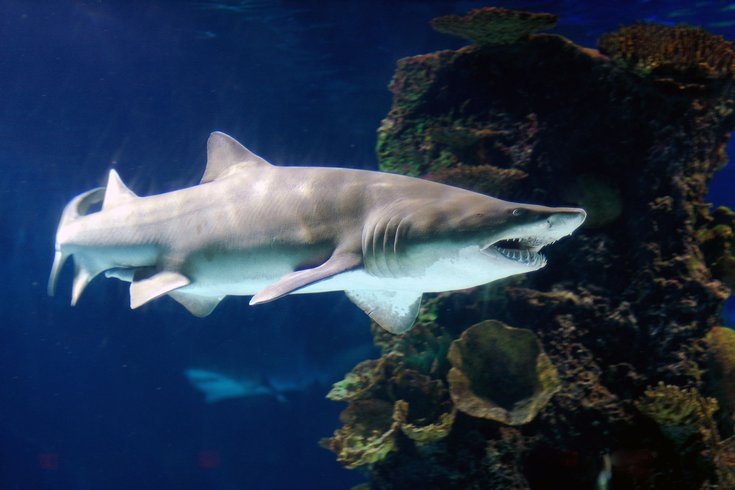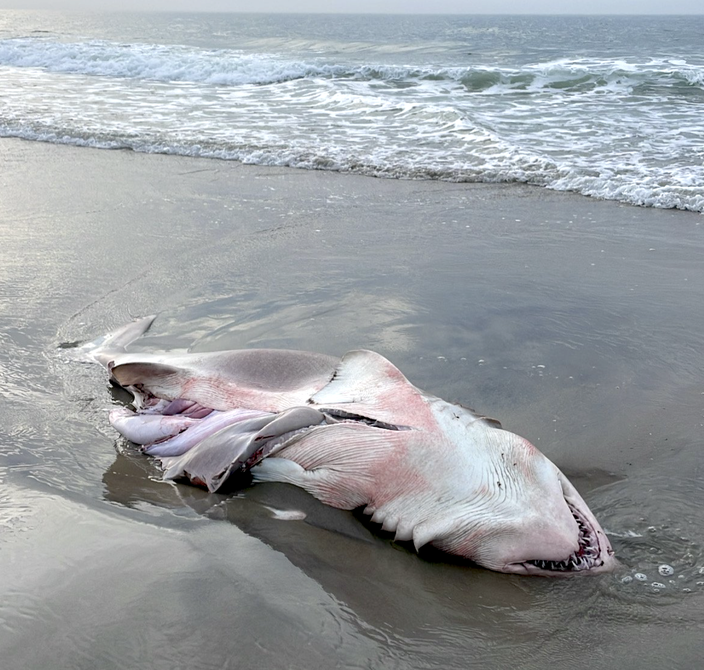
August 04, 2022
 Jeff Kubina/Creative Commons
Jeff Kubina/Creative Commons
The sand tiger shark pictured above was photographed at the Newport Aquarium in Kentucky. Two sand tiger sharks have been spotted at the Jersey Shore in the last week, one that washed up dead in Longport and another caught by a fisherman in Sea Isle City.
A New Jersey fisherman who goes by the name "shark man" lived up to his reputation last week when he reeled in a sand tiger shark in front of a crowd in Sea Isle City.
Realtor and fishing teacher PJ Brawn shared photos on Facebook of the catch he made at the Jersey Shore last weekend. The sand tiger shark measured about seven feet in length. Despite its size and fearsome look, the species isn't a threat to humans. The animal was released after it was brought to shore.
Sponsored by Discovery Shark Week 🦈 #SandTiger
Posted by Pj Braun on Sunday, July 31, 2022
In an interview with Fox & Friends, which has video of the catch, Braun said he was happy to put on a show for the people at the beach.
"Everyone's obviously happy to see a healthy release and snap a couple photos," Braun said.
The catch in Sea Isle City came during the same week a dead sand tiger shark washed ashore near the 12th Street beach in Longport. It's unclear how that shark died, but experts said it may have been caught by a fisherman and noted the gash down its belly.
"It looks like someone intentionally opened the animal post-mortem, likely after it was already on the beach," said Dr. Harley Newton, chief veterinarian at OCEARCH, one of the world's leading shark research organizations.
The sand shark found in Longport on Thursday morning showed signs of major injury and had been scavenged by shore birds.
It's unlawful in New Jersey to specifically fish for sand tiger sharks, which are federally protected.
"These sharks are non-aggressive and are a coastal species that often hangs out around wrecks and near-shore structures," Dr. Newton said. "They have one of the lowest reproductive rates of all sharks (a maximum of 2 pups every 2 to 3 years), which makes them very susceptible to fishery pressures. They are occasionally caught by surf casters in the region, but are a Prohibited Species from commercial or recreational fishing and should be released immediately, while still in the water if encountered."
After the Longport shark was found, Monmouth University biologist Keith Dunton noted that even when released, sharks caught by anglers are put at risk.
"Sand tigers, like many sharks, do not handle being captured very well and it is a stressful event for them," Dunton said. "Some sharks can die days to weeks later from the stress induced from being captured."
Sand tiger sharks are present throughout the mid-Atlantic region at this time of year. They shouldn't be confused with tiger sharks, which are bigger and more commonly aggressive toward people.
Shark sightings of various species have become more common at the Jersey Shore in recent years. Not only is there more research being done to help understand and conserve sharks, but the availability of smartphone cameras makes chance encounters with the public more likely to be shared online.
Braun speculated that this year's colder waters in New Jersey may have something to do with bigger sharks being witnessed more frequently.
"We've had a colder water season, so I do think that some of the bigger water sharks are in and the smaller sharks are out," Braun told Fox & Friends. "I'm not a scientist, but that's just my fishing theory."
Experts say shark conservation efforts play an important role in explaining the rising number of shark encounters along the East Coast. Great white populations, for instance, have rebounded due to federal protections covering both the sharks and their main prey, seals. The great whites move up the Atlantic coast during the summer months, peaking between August and October as they feed on a plentiful supply of seals.
In June, a 12-foot-long great white shark was filmed swimming around a fisherman's boat off the coast of Sea Isle City. And last month, OCEARCH tracked an 11-foot-long, 880-pound great white shark in the ocean near Atlantic City. That shark, named Freya, is one of many that the research organization has followed closely over the years.